Abstract
The relationship between effective blood volume and related hormones in burn patients following resuscitation is not well understood. Previous reports have suggested that hormone secretion is altered by a resetting of neural control mechanisms. Serum and urine sodium, plasma renin activity, serum ADH, cardiac index, effective renal plasma flow, and total blood volume were measured in seven burn patients (mean age, total burn size, and postburn day: 32 years, 56%, and 9 days, respectively). The same values (with the exception of cardiac index and blood volume) were measured in 10 control patients (mean age, 24 years). The blood volume of patients was measured by 51chromium red blood cell (RBC) labeling and compared to normal predicted values based on body surface area and sex. Mean serum sodium and osmolality were 138 mmol/L (millimolar) and 286 mosm/kg, respectively, in both patients and control subjects. Mean +/- standard error of the mean total blood volume in the patients was low, 81% +/- 4% of predicted values. Cardiac index and renal plasma flow were significantly elevated. Plasma renin activity and antidiuretic hormone (ADH) levels were elevated and altered in the direction expected from blood volume measurements despite the findings of increased blood flow. Dissociation of organ flow and hormonal response suggests that simultaneous direct blood volume measurements are necessary to elucidate factors other than altered neural control settings to explain hormonal changes in the flow phase of injury. Depressed total blood volume appears to promote elevated ADH levels in burn patients following resuscitation. Whether there is an additional role of altered neural control settings remains to be established.
Full text
PDF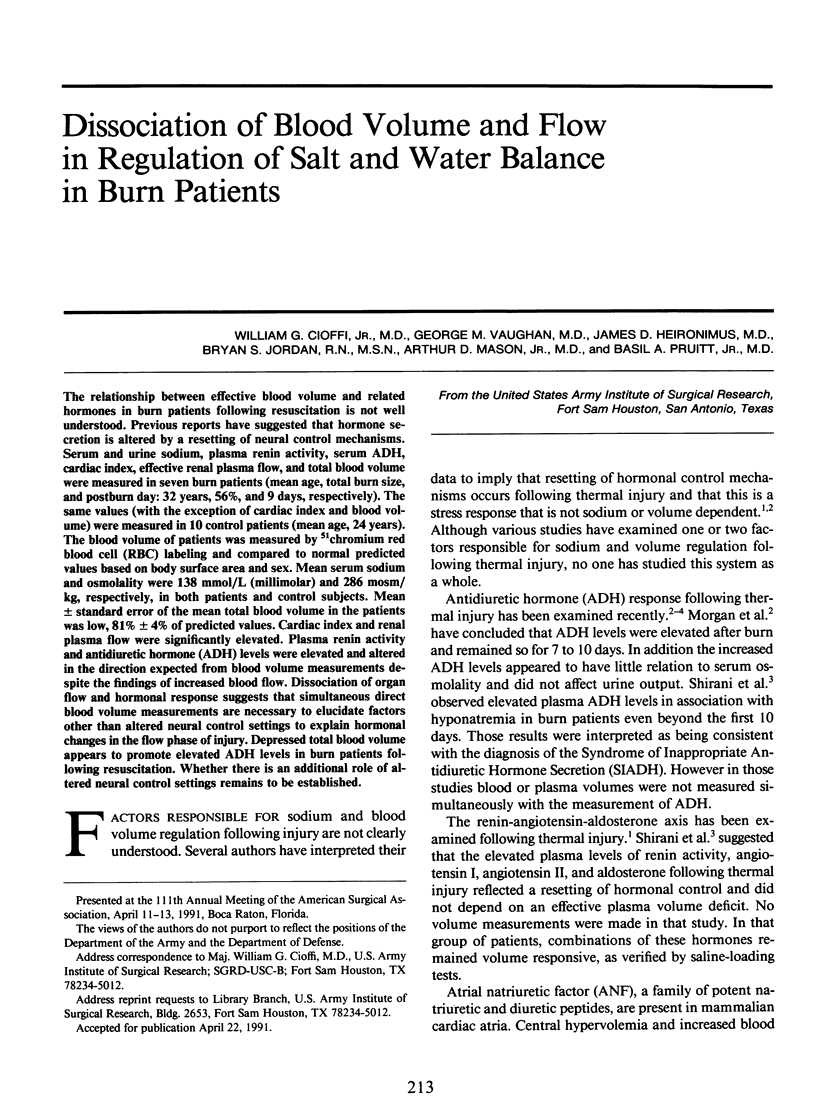
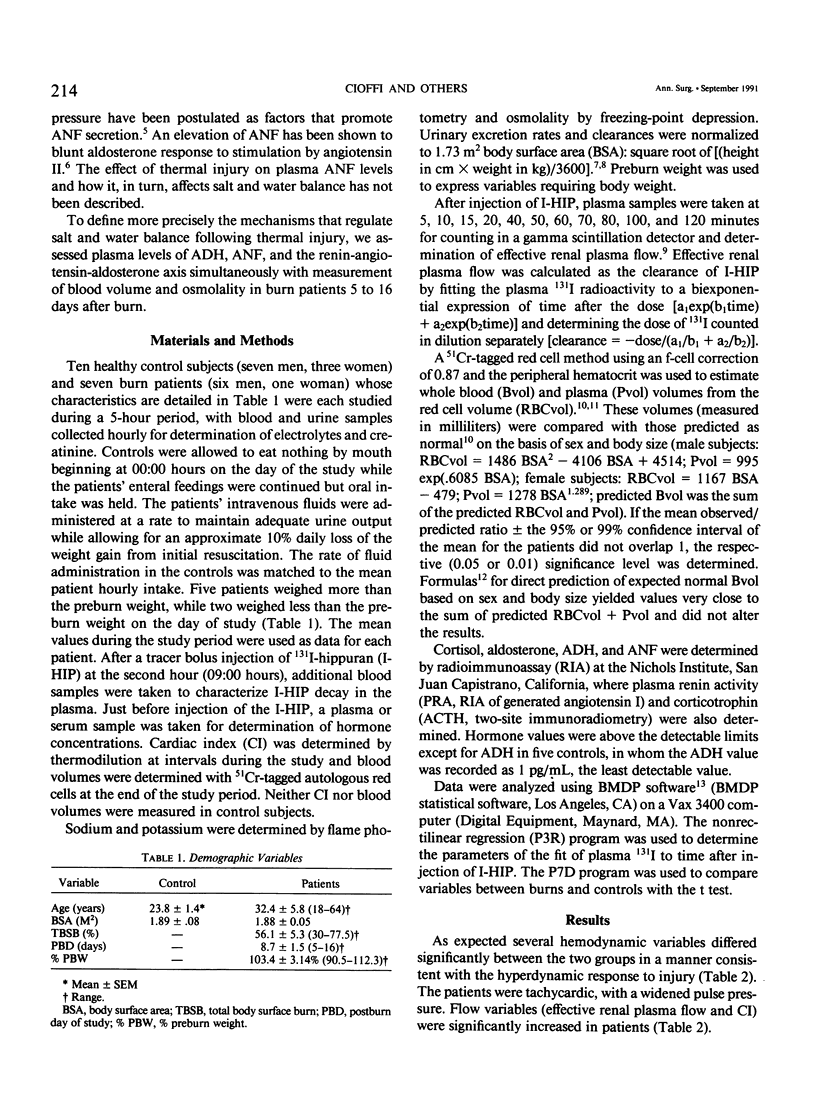
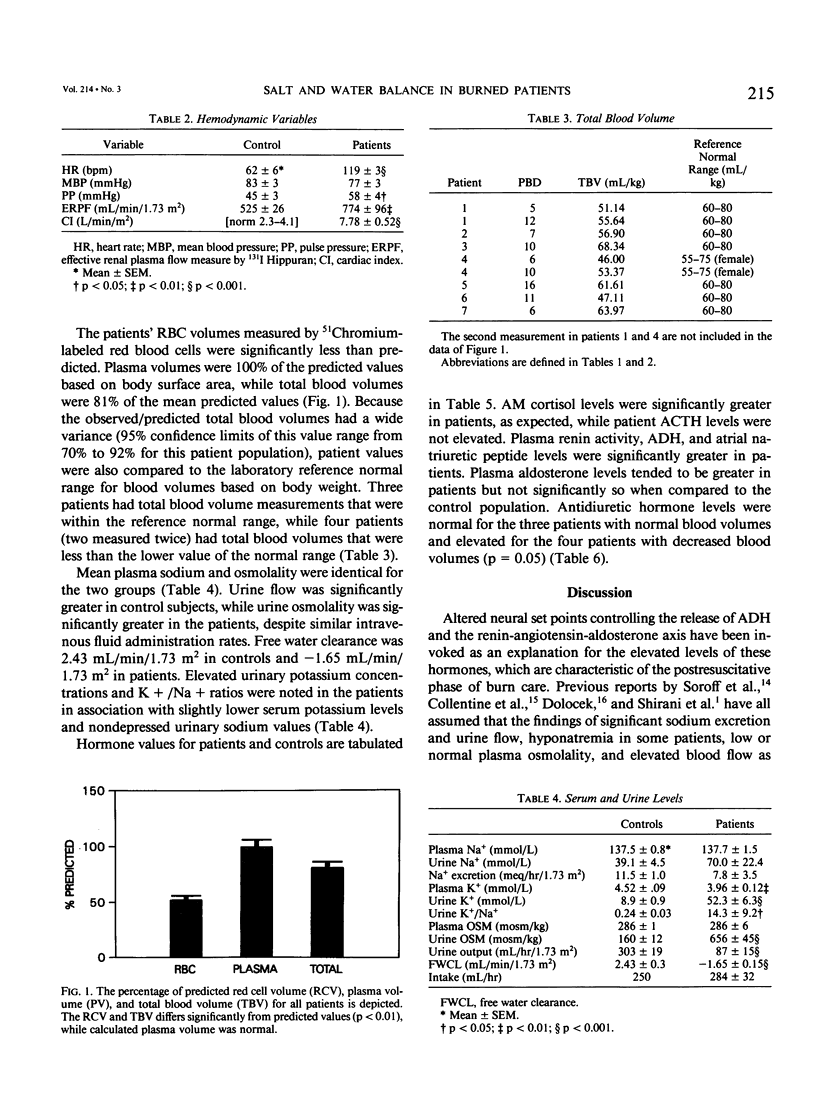
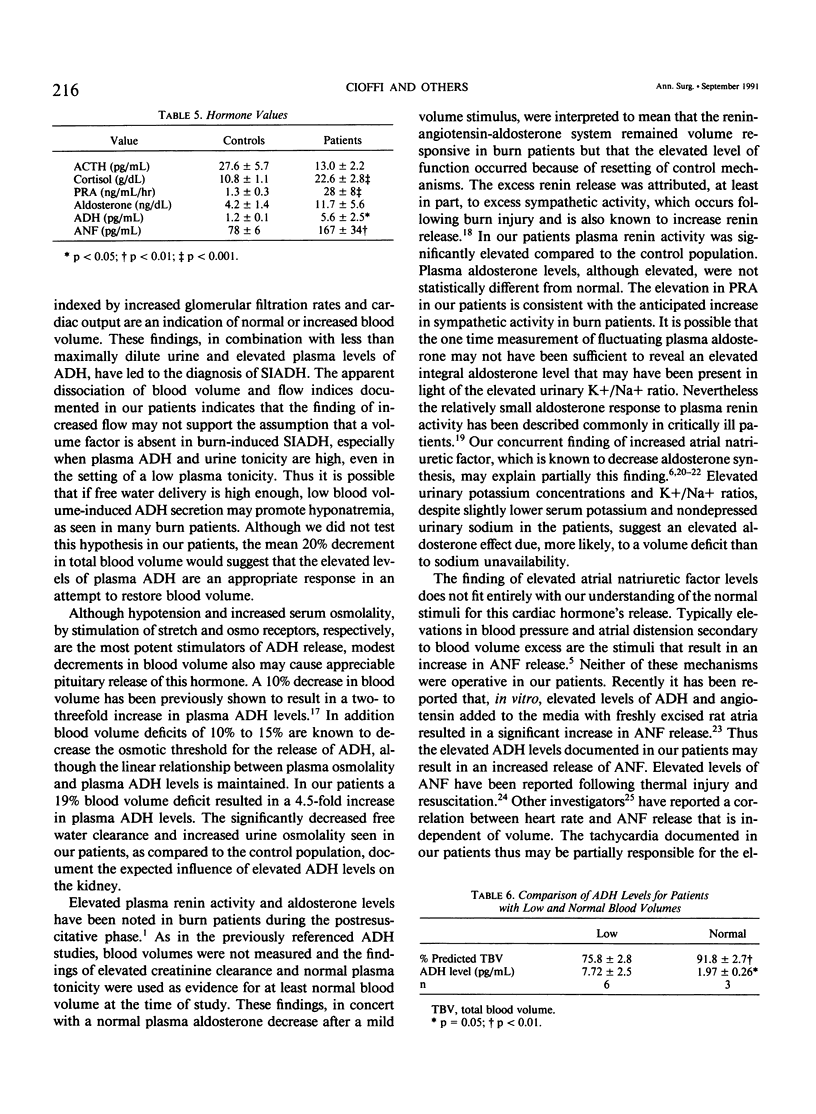
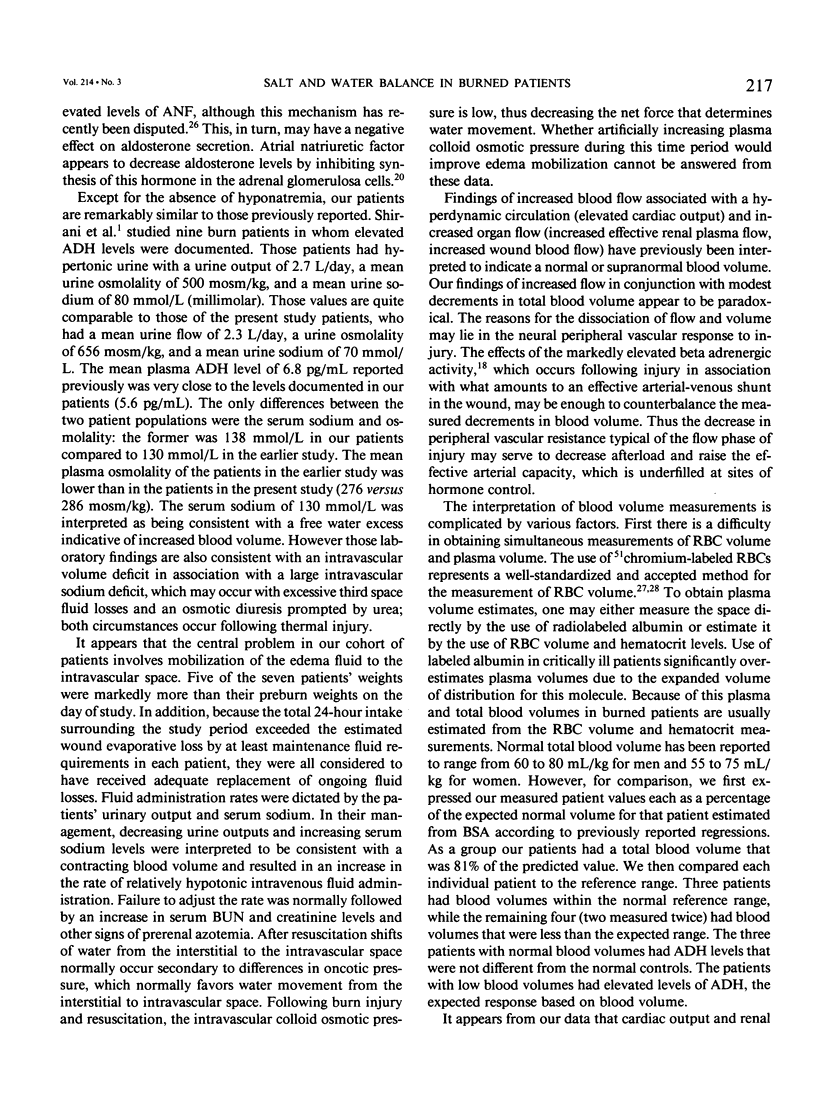
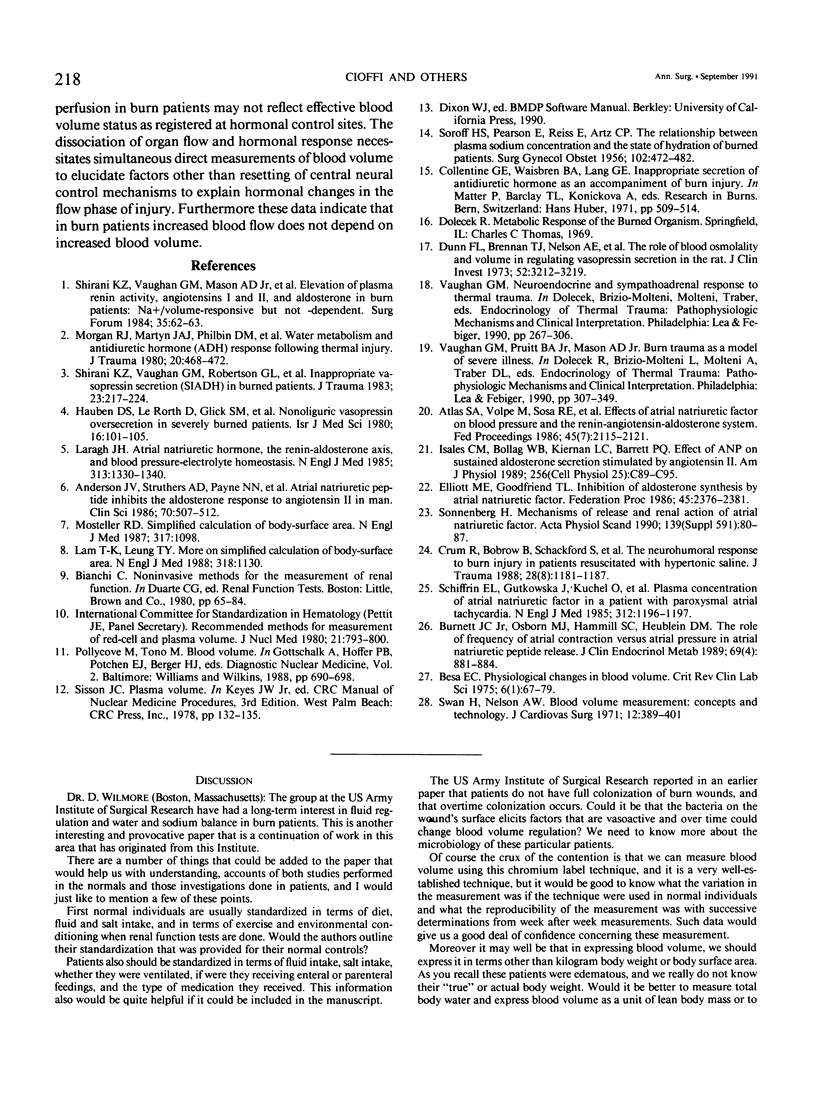
Selected References
These references are in PubMed. This may not be the complete list of references from this article.
- Anderson J. V., Struthers A. D., Payne N. N., Slater J. D., Bloom S. R. Atrial natriuretic peptide inhibits the aldosterone response to angiotensin II in man. Clin Sci (Lond) 1986 May;70(5):507–512. doi: 10.1042/cs0700507. [DOI] [PubMed] [Google Scholar]
- Atlas S. A., Volpe M., Sosa R. E., Laragh J. H., Camargo M. J., Maack T. Effects of atrial natriuretic factor on blood pressure and the renin-angiotensin-aldosterone system. Fed Proc. 1986 Jun;45(7):2115–2121. [PubMed] [Google Scholar]
- Besa E. C. Physiological changes in blood volume. CRC Crit Rev Clin Lab Sci. 1975 Jun;6(1):67–79. doi: 10.3109/10408367509151565. [DOI] [PubMed] [Google Scholar]
- Burnett J. C., Jr, Osborn M. J., Hammill S. C., Heublein D. M. The role of frequency of atrial contraction versus atrial pressure in atrial natriuretic peptide release. J Clin Endocrinol Metab. 1989 Oct;69(4):881–884. doi: 10.1210/jcem-69-4-881. [DOI] [PubMed] [Google Scholar]
- Crum R., Bobrow B., Shackford S., Hansbrough J., Brown M. R. The neurohumoral response to burn injury in patients resuscitated with hypertonic saline. J Trauma. 1988 Aug;28(8):1181–1187. doi: 10.1097/00005373-198808000-00008. [DOI] [PubMed] [Google Scholar]
- Dunn F. L., Brennan T. J., Nelson A. E., Robertson G. L. The role of blood osmolality and volume in regulating vasopressin secretion in the rat. J Clin Invest. 1973 Dec;52(12):3212–3219. doi: 10.1172/JCI107521. [DOI] [PMC free article] [PubMed] [Google Scholar]
- Elliott M. E., Goodfriend T. L. Inhibition of aldosterone synthesis by atrial natriuretic factor. Fed Proc. 1986 Aug;45(9):2376–2381. [PubMed] [Google Scholar]
- Hauben D. J., Le Roith D., Glick S. M., Mahler D. Nonoliguric vasopressin oversecretion in severely burned patients. Isr J Med Sci. 1980 Feb;16(2):101–105. [PubMed] [Google Scholar]
- Isales C. M., Bollag W. B., Kiernan L. C., Barrett P. Q. Effect of ANP on sustained aldosterone secretion stimulated by angiotensin II. Am J Physiol. 1989 Jan;256(1 Pt 1):C89–C95. doi: 10.1152/ajpcell.1989.256.1.C89. [DOI] [PubMed] [Google Scholar]
- Lam T. K., Leung D. T. More on simplified calculation of body-surface area. N Engl J Med. 1988 Apr 28;318(17):1130–1130. doi: 10.1056/NEJM198804283181718. [DOI] [PubMed] [Google Scholar]
- Laragh J. H. Atrial natriuretic hormone, the renin-aldosterone axis, and blood pressure-electrolyte homeostasis. N Engl J Med. 1985 Nov 21;313(21):1330–1340. doi: 10.1056/NEJM198511213132106. [DOI] [PubMed] [Google Scholar]
- Morgan R. J., Martyn J. A., Philbin D. M., Coggins C. H., Burke J. F. Water metabolism and antidiuretic hormone (ADH) response following thermal injury. J Trauma. 1980 Jun;20(6):468–472. doi: 10.1097/00005373-198006000-00006. [DOI] [PubMed] [Google Scholar]
- Mosteller R. D. Simplified calculation of body-surface area. N Engl J Med. 1987 Oct 22;317(17):1098–1098. doi: 10.1056/NEJM198710223171717. [DOI] [PubMed] [Google Scholar]
- SOROFF H. S., PEARSON E., REISS E., ARTZ C. P. The relationship between plasma sodium concentration and the state of hydration of burned patients. Surg Gynecol Obstet. 1956 Apr;102(4):472–482. [PubMed] [Google Scholar]
- Schiffrin E. L., Gutkowska J., Kuchel O., Cantin M., Genest J. Plasma concentration of atrial natriuretic factor in a patient with paroxysmal atrial tachycardia. N Engl J Med. 1985 May 2;312(18):1196–1197. doi: 10.1056/NEJM198505023121822. [DOI] [PubMed] [Google Scholar]
- Shirani K. Z., Vaughan G. M., Robertson G. L., Pruitt B. A., Jr, McManus W. F., Stallings R. J., Mason A. D., Jr Inappropriate vasopressin secretion (SIADH) in burned patients. J Trauma. 1983 Mar;23(3):217–224. doi: 10.1097/00005373-198303000-00007. [DOI] [PubMed] [Google Scholar]
- Sonnenberg H. Mechanisms of release and renal action of atrial natriuretic factor. Acta Physiol Scand Suppl. 1990;591:80–87. [PubMed] [Google Scholar]
- Swan H., Nelson A. W. Blood volume measurement: concepts and technology. J Cardiovasc Surg (Torino) 1971 Sep-Oct;12(5):389–401. [PubMed] [Google Scholar]


